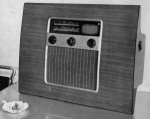> "pu" means "pickup" which in their case means phono pickup.
Yeah, but it means the OLD electric Victrola pickup, not a modern pickup.
The old ones were pretty much telephone earpieces, with a needle stuck to the diaphragm, mounted in an acoustic-style tone arm. With a hot fast 78, you got over 0.1V of semi-equalized signal, a far cry from the 0.005V of modern needles which also need electric EQ.
The output of an old pickup is close to the weak-station output of a radio detector. You might get 6V on a strong local station, but you might have distant stations 30dB weaker (even after AVC), so the audio amp was scaled for around 0.2V sensitivity. Work backward: classic power pentode needs 8V signal, hi-Mu triode has gain like 40, 8/40= 0.2V. (*)
A hard-strummed power chord on a hot gitar will beat 0.2V, but your fingers get tired. We like guitar-amp sensitivity in the 0.05V to 0.01V range. The "PU" input hardly cuts it. We need another gain of 4 to 20.
What we got? Right before the hi-Mu triode we find the IF stage. I had NO idea what a "VP41" was, except that it works as an IF amp; it'll work as an AF amp if we replace the tuned circuit and detector with a resistor. Most small pentodes can be cranked to gain of 100, but they get fussy, and we don't need that much. When trode-strapped (see how I moved the screen grid to the plate) they give theoretical gain of 10 to 40: I dunno which we'll get, but it hardly matters. Copying the 47K resistor from the audio stage (and stealing some of its clean DC power) will give actual gain of 10 to 20, which is in the ballpark of what we need.
The VP41 turns out to be (no surprise) a variable-gain tube. For large input signals, it would distort. That's not a defect in a funky guitar amp. But for our small guitar signals, the distortion will be very small. Mazda says that, as an IF amplifier, you can poke 5V at it! Audio linearity is different than IF linearity, but I bet it can take 0.1V strums with mild sweetening, and 1V bangs without getting offensive. (When you want offensive, crank the output past its 5 watt ability: it'll go nasty, until the old speaker shatters.)
Stick with the tubes that are in it: there is a good chance they are OK. If not, and you can't find replacements, you have a problem: these tubes use a 4V heater, and most post-war tubes use 6V heat. To use good old 6V6 and similar favorites, you'd have to add a new transformer just to power the 6V heaters. Not a big deal, but annoying. The PEN45 should be an excellent gitar-amp bottle, really too good for a radio. (This looks like a very deluxe radio.)
Since you say it plays, with the expected low gain, we know V3 and V4 "work". We won't know if V4 works to its full 5 watt level until we jam a bigger signal into it: but hell, 2 Watts is still a lot of racket in a good speaker.
(*) OK, HL41 only has mu of 30, typical working gain of 20, but the PEN45 can be pushed to clipping with just 6 or 7 volts. 6/20= 0.3V, near enough to the wild-guess. LH41 may have stuningly low distortion under these conditions, so it is good the input tube is a little bent.
If gain is almost-enough, change the plate resistor on V2 from 47K to 100K or 220K.
The tone control is treble-cut only. It controls the treble-rise of a dynamic speaker on a pentode, and it cuts the hiss off of AM, SW, and 78s. For guitar we want a little treble-rise. If it has enough gain, but isn't bright enough, change that new 25uFd cap under V2 to a 1uFd. Treble gain stays the same, bass-gain drops a bit, the basic guitar-amp sound.
BTW, V1 is a Triode-Heptode. You'll be the only dude on the block with a Heptode in his amp. (Don't tell them it isn't doing anything for the guitar.)





